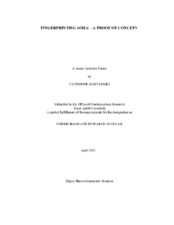| dc.contributor.advisor | Morgan, Cristine | |
| dc.creator | Kobylinski, Catherine | |
| dc.date.accessioned | 2013-06-04T16:10:27Z | |
| dc.date.available | 2013-06-04T16:10:27Z | |
| dc.date.created | 2011-05 | |
| dc.date.issued | 2011-05-06 | |
| dc.date.submitted | May 2011 | |
| dc.identifier.uri | https://hdl.handle.net/1969.1/ETD-TAMU-2011-05-9555 | |
| dc.identifier.uri | https://hdl.handle.net/1969.1/148758 | |
| dc.description.abstract | Forensic soil characterization is an under-explored field in the forensic sciences. One aspect of forensic sciences is Locard’s Exchange Principle, which states that every
contact leaves a trace. As soil characterization technology improves, applications of soil forensics can more accurately identify if a soil sample collected from a suspect corresponds to samples collected at a crime scene. This research focuses on the use of visible near and infrared, diffuse reflectance spectroscopy (VNIR DRS) to develop spectral “fingerprints” of soils. Our hypothesis is that VNIR spectra of soils from a crime
scene are unique from other soils, even soils of the same soil series. If soil spectra from a crime scene are unique, this data can be used to accurately assess Locard’s Exchange Principle. Soil samples were collected within in a thirty-mile radius of a designated
“crime scene” in the Brazos River floodplain near Texas A | en |
| dc.format.mimetype | application/pdf | |
| dc.subject | Locard’s Exchange Principle | en |
| dc.subject | VNIR Spectroscopy | en |
| dc.subject | Soil Forensics | en |
| dc.title | FINGERPRINTING SOILS – A PROOF OF CONCEPT | en |
| dc.type | Thesis | en |
| thesis.degree.department | Soil and Crop Sciences | en |
| thesis.degree.discipline | Bioenvironmental Sciences | en |
| thesis.degree.grantor | Honors and Undergraduate Research | en |
| thesis.degree.name | Bachelor of Science | en |
| dc.type.material | text | en |
| dc.date.updated | 2013-06-04T16:10:27Z | |


